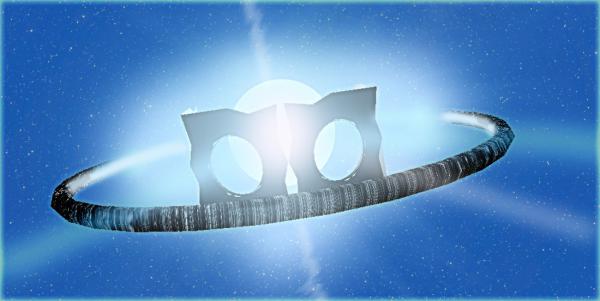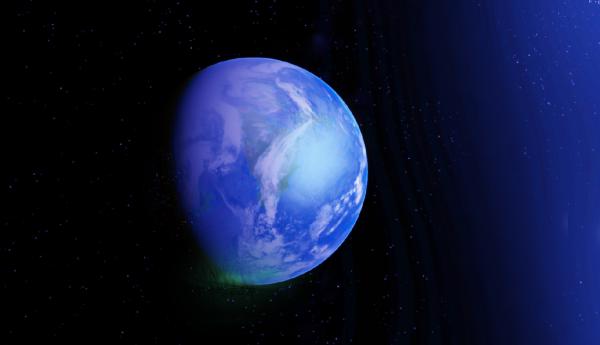BY LETTER
Big Ben's World
Galactography > Regions of Space > Middle Regions/Hinter-regions
Galactography > Sephirotic Empires > Non-Coercive Zone (NoCoZo)
Galactography > Systems and Worlds > Systems & Worlds A - B
Galactography > Sephirotic Empires > Non-Coercive Zone (NoCoZo)
Galactography > Systems and Worlds > Systems & Worlds A - B
 Image from Steve Bowers | |
| The bright star HD 217086, showing the megastructure known as the Clocktower. Encircling the star and the Clocktower is the Brainbox, a comptronium bank; at the poles can be seen the Fountains, artificial mass ejection systems for starlifting. | |
Early in the 3900s A.T., Big Ben Janson, a minor transapient of the Non-Coersive Zone, created a clade of tweaks with which to colonize a world e was establishing around HD 217086. Big Ben had large plans - e wanted to begin a large stellar husbandry project, and create all the infrastructure e would need for greater ascension. Due to the star's spectral emissions being greater in UV, Big Ben genegineered an entire neogen biosphere for eir infant colony world, and once everything was in place, e seeded eir project world with life.
By 8200, Big Ben had evidently ascended as e had planned, because e left, abandoning the world and much of the infrastructure e had built, leaving the world in the care of some of eir lieutenants. As of 10K a.t., Big Ben's current location and status are unknown. Some speculate that e goes by a different name now.
Data Panel HD 217086 | |
| System | Big Ben's World |
|---|---|
| PRIMARY | HD 217086 in Cepheus B molecular cloud, near the Cave Nebula |
| TYPE | O-type blue supergiant |
| LUMINOSITY | 9700 x Sol |
| DISTANCE FROM SOL | 1424 ly |
| Constellation | Cepheus |
| PLANETS | Big Ben's World |
| WORMHOLE LINKS: | 1 (to the nearest NoCoZo sector wormhole hub) |
| AI OVERSEERS | Currently a council of minor transapients |
| AFFILIATION | loosely aligned with the NoCoZo |
| LOCAL GOVERNMENT | Democratically elected transapient council |
| POPULATION | 55 billion |
| POPULATION BREAKDOWN | (all figures approximate) 6 billion UV adapted tweaks ('Bennies') 2 billion vacuum adapted humans 8 billion vecs of various design 15 billion virtuals of various origin 13 billion nearbaseline humans of various clade 11 billion sophont alife. less than 100 transapients of first and second singularity |
| MEAN TECH LEVEL | Transapientech |
| INDUSTRY | Energy production, bulk computronium |
 Image from Steve Bowers | |
| Big Ben's world, an artificial planet in this system | |
Big Ben's World
The only planet in the system appears to be of artificial origin due to its very presence. It is very rich in lighter metals, has a surface gravity of 13 m/s/s and has been terraformed to the point that a typical nearbaseline human can survive without environmental conditioning, provided they don't spend very much time exposed to sunlight. Ozone concentration in the atmosphere of Big Ben's World does give the air a somewhat acrid smell, according to most nearbaselines, and indeed their biochemistry might suffer from high levels of ozone exposure - though this is not so disruptive that a typical personal medical system couldn't correct for it. Due to the very fast and powerful stellar wind coming from Cepheus B, even at the planet's wide 82 AU orbit, Big Ben's World has very bright auroras that cover most of the surface every night.The planet itself appears to be artificial in construction, as blue supergiant stars tend to not last long enough and be a hostile environment for planetary formation. Big Ben left no information on whether or not e had artificially accreted the planet, had moved it into its current orbit from another location, or indeed, if e found it in situ. The planetary crust is enriched in light metals compared to other garden worlds, and of similar composition to the large molecular cloud Cepheus B is known for, leading many to conclude that the planet was created from local matter either artificially or, somehow, naturally.
Life on Big Ben's World
Though not as diverse as most biospheres, Big Ben's World does have a functioning ecology with organisms in every niche of the web of life. All of them are adapted to life on Big Ben's World, with its strong ultraviolet light. Plants have their photosynthesis operation shifted to higher frequencies of light, making most plants appear orange instead of green. Nearly all animals and fungi deposit titanium dioxide under their skins as a pigment and UV blocker. This is possible because of the high prevalence of titanium in the soil of Big Ben's world.There are quite a few animals and plants that make extensive use of fluorescence and phosphorescence in their coloring and pigmentation. The jungles of Big Ben's World's equatorial region glow rather brightly for the first few hours of darkness every night. One of Big Ben's World's better known exports is a luxury good known as "Phosphorescent Honey", which is created by a colony insect bee-equivalent in the tropical rainforests near the equator. This substance is a milky white and viscous liquid that displays blue phosphoresce and is rich with L-Glucose and very sweet, though the sulfur content does make it an acquired taste. This can be fermented by fungi local to Big Ben's World, turning it into Phosphorescent Mead - making it much more palatable to standard hu tastes, as the fungi absorb much of the sulfur.
Bennies
Big Ben also created a breed of nearbaseline human to live on eir world who also share in the titanium-derived UV protection. Experts argue over whether to refer to the Bennies as tweaks or outright neogens. Though large sections of their genome are similar to baseline humanity, they also contain a significant portion of novel genetic material. Big Ben Janson is no longer present, e cannot be reached for comment. Overall, they tend to be shorter and squatter than baseline humanity, and have pale white skin. Their visual spectra has been extended into the near ultraviolet, with a weakening of their ability to detect long-wavelength light, making reds and oranges muted. "Bennies," as they are sometimes called, have a highly altered biochemistry that allows them to tolerate extreme concentrations of titanium dioxide as compared to standard nearbaseline humanity. This alterations does, however, have the side effect of making them very susceptable to lithium poisoning.The skin of Bennies is laced with chromatophores loaded with many different phosphorescent and fluorescent matierals. These chromatophores can be consciously controlled by the Bennies, allowing them to fluoresce in a multitude of colors when in bright UV light, and phosphoresce after absorbing sufficient light. Bennies appear to have direct conscious control of their chromatophores on a roughly 4 square millimeter scale. Control of this ability varies from person to person, depending on innate talent and practice. Indeed an entire philosophical and physical training tradition has been created by the Bennies to better control their chromatophores. This training tradition is somewhat similar to various ancient martial art training programs, with some practitioners living as ascetic monks. Seasoned practitioners of this art can actually manage to create full motion video displays on their skin, even if the resolution is poor.
Bennies, when not eating titanium-rich food, require titanium supplements to maintain health. A Bennie starved of titanium will see eir skin take on a gray and dull color as titanium starvation sets in.
Orbital Habitats
The Clocktower
In a tight stellar orbit around Cepheus B is a huge orbital installation called "The Clocktower". This was, before e abandoned it, Big Ben's home in the system. It is a very large array of solar collectors and other, less well understood, machinery. Currently it is controlled by the elected council, who gives grants to scholars to study the machinery and attempt to discern what exactly it does. Many great modosophont technological breakthroughs have come from studying these devices, and its energy collector array sends energy to the entirety of the system.The Brain Box
Opposite The Clocktower, and in a little higher stellar orbit, is a huge bank of computronium that contains the bulk of the system's virtual inhabitants. There are no facilities for the embodied in The Brain Box, but the facilities for virtual entities are unparalleled in the stellar vicinity. It was built with technology left behind by Big Ben in The Clocktower. One of the first discoveries when Big Ben turned control of The Clocktower over to eir lieutenants was a machine that if fed silicon, carbon and various rare-earth dopants, would produce bulk computronium of remarkable efficiency in the form of truncated octahedron shaped blocks 1 meter along an edge with power and information ports on all fourteen sides. The Brain Box and portions of The Clocktower are built of these blocks.The Brain Box has large power collection arrays, and a huge array of antennas pointed to the station at the wormhole on the edge of the system.
The Harvester and The Fountains
Operating by means of unknown technology of transapient origin is a huge machine in polar orbit of Cepheus B. Below the surface of Cepheus B, at the axis of rotation, are two powerful pumps - probably created from magmatter - that cause the star to fling jets of plasma into space from its poles. These are referred to as "The Fountains". These stellar prominences are caught by the orbiting Harvester and processed into useable material and energy.Minor Habitat Orbitals
Along with the larger orbitals are hundreds of other, smaller orbital habitats of various designs and construction.Related Articles
Appears in Topics
Development Notes
Text by ROM 65536
Initially published on 17 August 2016.
Initially published on 17 August 2016.






